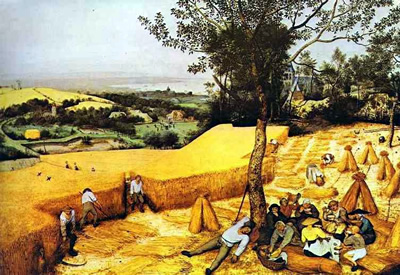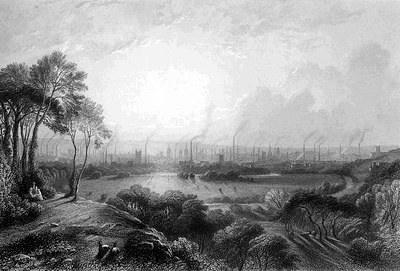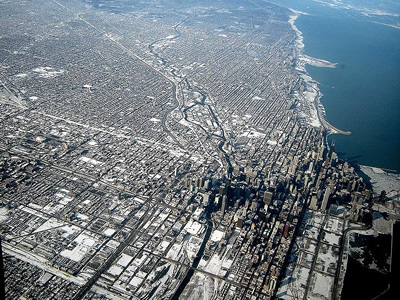The landscape is the visible result of various natural geological processes - the formation of rocks, their uplift into mountains, subsequent erosion of the mountains, distribution and deposition of eroded sediments, movements of the continents and the modification of coastlines by the action of the sea.
But most natural processes (with the exception of brief, powerful phenomena such as earthquakes) tend to take a long time to produce noticeable alterations, and during the past few thousand years by far the most significant landscape modifications have been produced by humans.
Humans are different from other animals in that we have markedly greater intelligence and technological ability. Thus we are less restricted by the constraints of ecology and evolution than are the other species that inhabit the Earth, and instead of adapting to our surroundings, we can modify the environment to provide for many of our needs.
Because of the relatively rapid development of technology and medicine, the human population has increased exponentially during the last 5,000 years; in geological terms this period is extremely short - only about one-millionth part of the time the Earth has existed - but during that time the world's population has increased to about 6.772 billion (in July 2009) and is expected to reach 9 billion by the year 2040.
In the process of providing food and dwellings for the continually increasing population we have, throughout history, substantially altered the natural world and today very little of the Earth's land surface remains in a virgin state.
Early Human Influences on Landscape
The earliest known fossils of modern Human (Homo sapiens) date from about 350,000 years ago. At that time most human communities obtained their food by hunting animals and by gathering edible wild plants from the surrounding countryside.
Because of their simple lifestyle and sparse population, these early hunter-gatherers had a negligible effect on the environment. With the development of primitive technology - the use of fire and the production of clothing - they were able to migrate from the warm areas of Africa, southern Europe and southern Asia to colder regions farther north; they managed to penetrate the American continent by crossing the land bridge across what is now the Bering Strait.
 The next stage in the development of human civilization was the adoption of a nomadic way of life. In areas with large seasonal climatic variations the animals on which the hunting tribes relied for food migrated to avoid the worst extremes of climate. And the tribes followed the animals to ensure a continuing food supply. Like the hunter-gatherers, nomadic hunters had a minimal effect on the environment.
The next stage in the development of human civilization was the adoption of a nomadic way of life. In areas with large seasonal climatic variations the animals on which the hunting tribes relied for food migrated to avoid the worst extremes of climate. And the tribes followed the animals to ensure a continuing food supply. Like the hunter-gatherers, nomadic hunters had a minimal effect on the environment.
The first change that had a major and lasting environmental effect was the development of agriculture some 10,000 to 12,000 years ago. Initially this involved collecting wild plants from the surrounding countryside and replanting them close to the human settlements. As agriculture became established, crops were grown from seeds obtained from the previous season's yield. Although still relatively small-scale (because the total human population was sparse) early agriculture had a noticeable effect on the landscape because it required the clearing of natural vegetation to provide land for cultivation.
Animal husbandry followed, necessitating the clearing of more natural vegetation to provide grazing land. Furthermore, the development of farming as the main source of food was accompanied by the establishment of the first permanent settlements.
 The earliest agriculture took place in river valleys where frequent flooding ensured that the soil remained fertile - the Nile, Tigris, Euphrates and Indus valleys, for example. Elsewhere, "slash and burn" (or shifting) agriculture was employed. This method (which is still used in some parts of the world) involved clearing an area of its natural vegetation and burning it, then cultivating that land for a few years until the soil lost its fertility, after which the community moved on and cleared a previously untouched area.
The earliest agriculture took place in river valleys where frequent flooding ensured that the soil remained fertile - the Nile, Tigris, Euphrates and Indus valleys, for example. Elsewhere, "slash and burn" (or shifting) agriculture was employed. This method (which is still used in some parts of the world) involved clearing an area of its natural vegetation and burning it, then cultivating that land for a few years until the soil lost its fertility, after which the community moved on and cleared a previously untouched area.
The overall result of the development of agriculture was to ensure a relatively reliable source of food that was easy and safe to gather (unlike the much more hazardous hunting lifestyle) which, in turn, led to an increase in the human population. But the advent of settled agriculture also marked the beginning of extensive alterations to the environment.
Industrialization
 The most dramatic changes to the landscape have been caused by industrialization which, although its origins can be traced back to Stone-Age Man, has had by far the greatest effect in Western Europe since the Industrial Revolution of the mid-nineteenth century.
The most dramatic changes to the landscape have been caused by industrialization which, although its origins can be traced back to Stone-Age Man, has had by far the greatest effect in Western Europe since the Industrial Revolution of the mid-nineteenth century.
Primitive industry began in areas where there was a natural resource suitable for exploitation. Such a resource - a deposit of flint from which Stone-Age Man could make arrowheads, for example - was worked by the local community, which could then trade its surplus for commodities it lacked.
Later, with the development of efficient transport and communications, trade was eventually possible between places anywhere in the world. Good communications affected the environment not only directly (by building of roads and railways, for example) but also indirectly by stimulating industrialization throughout the world - a process that is continuing today, most notably in underdeveloped countries.
 Hence our agricultural and industrial civilization has altered almost all of the natural landscape: forests have been cut down and the land used for crops; mountains have been quarried for valuable minerals; animal and plant communities have been changed irrevocably; and the communications' networks extend across the globe.Even if Humans suddenly disappeared from the face of the Earth, the results of our environmental modifications would be long-lasting, and it would probably take thousands of years for a truly natural landscape to re-establish itself.
Hence our agricultural and industrial civilization has altered almost all of the natural landscape: forests have been cut down and the land used for crops; mountains have been quarried for valuable minerals; animal and plant communities have been changed irrevocably; and the communications' networks extend across the globe.Even if Humans suddenly disappeared from the face of the Earth, the results of our environmental modifications would be long-lasting, and it would probably take thousands of years for a truly natural landscape to re-establish itself.